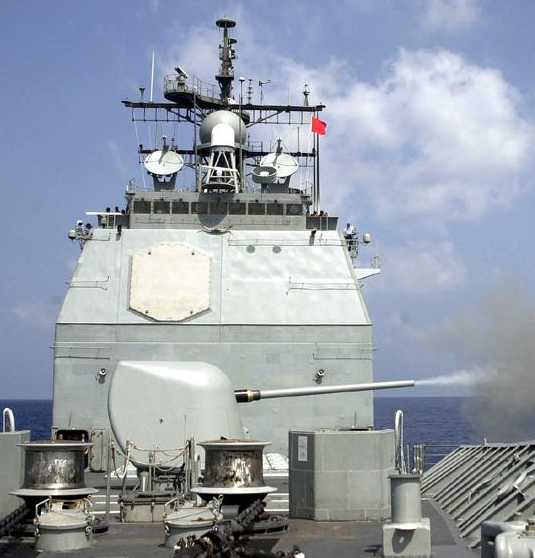Fully automatic, this lightweight gun system offers significant improvements in reliability and maintainability over the previous 5"/54 (12.7 cm) Mark 42 gun systems. The mount is unmanned above deck and all mechanisms have been greatly simplified. It is claimed that this is the lightest 5-in (12.7 cm) mount in the world, however, it is also one of the slowest firing. The gun-house is watertight and has zone-temperature controlled de-icing of the gunport. Misfired rounds are automatically removed. Mod 0 required special procedures in order to change ammunition types. The Mod 1 version incorporated a major improvement in that it is able to select and fire six different kinds of ammunition at the push of a button, thus increasing the speed at which it can respond to changing threats. Mod 0 used a mechanical fuze setter while Mod 1 has an electronic fuze setter.
The Mark 45 is controlled by either the Mark 86 Gun Fire Control System or the Mark 160 Gun Computing System and can engage surface, shore or aircraft targets.
This weapon system has been exported to Australia, New Zealand, Greece, Spain, Turkey and Thailand.
The Mark 45 was used as the basis for the mid-1990s Navy/DNA electro-thermal chemical (ETC) advanced technology demonstration. ETC propulsion offered greatly enhanced velocities and ranges from traditional gun designs. The US Army is currently evaluating and developing this technology.
A 23 August 2007 BAE press release stated that BAE had been awarded a contract for the overhaul, manufacture and upgrade of these guns and mountings as part of the CG-47 Cruiser Modernization program. These ships will replace their existing guns and mountings with the Mark 45 Mod 4.
The Mark 19 Mod 0 is a two-piece with replaceable liner, Mod 1 is a one piece design. Improved metallurgy gives this weapon about twice the service life of the Mark 18.
Nomenclature note: In the late 1940s, the USA changed from designating guns by the gun itself over to the gun mounting. "Mark 45" is actually the gun mount designation, the gun itself is the Mark 19 and is an improved version of the previous 5"/54 (12.7 cm) Mark 18 gun used with the Mark 42 Mount.
| Designation | Gun: 5"/54 (12.7 cm) Mark 19
Mount: 5"/54 (12.7 cm) Mark 45 |
|---|---|
| Ship Class Used On | Tarawa (LHA-1), California (CGN-36), Virginia (CGN-38), Ticonderoga (CG-47), Arleigh Burke (DDG-51), Spruance (DD-963) and Kidd (DDG-993) classes |
| Date Of Design | Mod 0: About 1968
Mod 1: 1977 1 |
| Date In Service | Mod 0: 1971
Mod 1: 1980 Mod 2: about 1988 |
| Gun Weight | Mark 19 Mod 0 (two piece with liner): 3,560 lbs. (1,615 kg)
Barrel liner for Mark 19 Mod 0: 2,840 lbs. (1,228 kg) Mark 19 Mod 2 (one-piece): 3,560 lbs. (1,615 kg) |
| Gun Length oa | N/A |
| Barrel and Bore Length | 270.0 in (6.858 m) |
| Rifling Length | 229.07 in (5.820 m) |
| Grooves | N/A |
| Lands | N/A |
| Twist | Uniform RH 1 in 25 |
| Chamber Volume | N/A |
| Rate Of Fire | 20 rounds per minute nominal (in automatic mode)
16 rounds per minute when using the fuse setter (MT-PD rounds) Terminally guided munitions are restricted to 10 rounds per minute |
- ^Mod 1 development began in 1977 and the gun was first tested in February 1980 aboard USS Briscoe DD-977.
| Type | Separate |
|---|---|
| Projectile Types and Weights 1a 2a 3a | Mark 68 HE-CVT - 68.5 lbs. (31.1 kg)
Mark 80 HE-PD - 67.6 lbs. (30.7 kg) Mark 91 Illum-MT 4a - 63.9 lbs. (29.0 kg) Mark 116 HE-VT - 69.7 lbs. (31.6 kg) Mark 127 HE-CVT - 68.6 lbs. (31.1 kg) Mark 156 HE-IR - 69.0 lbs. (31.3 kg) |
| Bursting Charge | See Note 5a |
| Projectile Length | Mark 68 - 26.1 in (66.3 cm)
Mark 80 - 26 in (66 cm) Mark 91 - 26.1 in (66.3 cm) Mark 116 - 26 in (66 cm) Mark 127 - 26 in (66 cm) Mark 156 - 26 in (66 cm) |
| Propellant Charge | Mark 67 - 18.25 lbs. (8.3 kg)
Cartridge weighs 38.9 lbs. (17.6 kg) filled |
| Muzzle Velocity | Most rounds using Mark 67 cartridge - 2,650 fps (808 mps)
Mark 91 Illum with Mark 67 cartridge - 2,700 fps (823 mps) |
| Working Pressure | 18.5 tons/in2 (2,758 kg/cm2) |
| Approximate Barrel Life | 8,000 rounds |
| Ammunition stowage per gun | Ticonderoga: 600 rounds
Arleigh Burke: 680 rounds 6a Others: 475 - 500 rounds |
- ^This weapon has many different kinds of ammunition. The ones listed above are meant to be representational, but by no means is this a complete listing.
- ^Ammunition abbreviations:
HE-PD = High Explosive, Point Detonating Fuze
HE-VT = High Explosive, Variable Time Fuze
HE-CVT = High Explosive, Controlled Variable Time Fuze
HE-IR = High Explosive, Infrared Fuze
Illum - MT = Illumination, Mechanical Time Fuze
MT-PD = Mechanical Time, Point Detonating Fuze - ^This weapon is capable of using the Hypervelocity Projectile (HVP). See 5"/62 (12.7 cm) Mod 4 data page for additional information.
- ^The illumination round burns for approximately 50 seconds.
- ^Most conventional rounds have a warhead of about 7.75 lbs. (3.515 kg).
- ^The Arleigh Burke class ammunition magazine takes approximately 16 hours to be loaded out with 680 ballistic projectiles and associated propelling charges during at-sea replenishments. This assumes favorable weather conditions and calm seas. The Ticonderoga class requires 12 to 16 hours for each 600 round magazine, assuming that sufficient manpower and replenishment assets are available to simultaneously resupply both forward and aft magazines.
- All projectiles have a 0.5 caliber boat-tail.
- The gun feeds from a single loader drum holding 20 projectiles and cartridges. The fuze setter is located directly above the transfer station, which feeds rounds from the drum into the upper hoist.
| Elevation | Range |
|---|---|
| 47 degrees | 25,290 yards (23,130 m) |
| Effective Range | 16,400 yards (15,000 m) |
| AA Range @ 65 degrees | 23,000 feet (7,000 m) |
| Illumination | 18,085 yards (16,540 m) |
Illumination rounds are automatically timed to ignite at an altitude of 1,050 feet (320 m) over the target area.
| Designation | Single Mounting 1b Tarawa (2), California (2), Virginia (2), Ticonderoga (2), Arleigh Burke (1), Spruance (2) and Kidd (2) classes: Mark 45 |
|---|---|
| Weight | Mounting without lower hoist: 49,000 lbs. (22,226 kg)
Mounting with four-flight lower hoist: 54,150 lbs. (24,108 kg) |
| Elevation | -15 / +65 degrees 2b |
| Elevation Rate | 20 degrees per second |
| Train | +170 / -170 degrees |
| Train Rate | 30 degrees per second |
| Gun recoil | 19 to 21 in (48 to 53 cm) 3b |
- ^This mounting consists of two groups, the upper and lower. The lower structure (below deck) delivers an uninterrupted flow of ammunition and contains the mount control unit, loader drum, fuze setter, hoist and lower accumulator system. The upper structure consists of the gun house shield, upper accumulator system and mechanisms to load the gun, lay the gun, fire the gun and handle the spent cartridge.
- ^Since the maximum elevation of this mounting is limited to 65 degrees, there is no need for a complex cradle system to move ammunition around the gun and then throw it into a loading tray from above. Instead, the gun is fed from below by a cradle swinging out and up from a fixed ammunition hoist in the center of rotation of the mount. Rounds are rammed directly from the cradle, which follows the rotation of the mount. As mentioned, the ammunition hoist is fixed in rotation and feeds from a single drum loader. The result of this design is a very light mounting at the cost of a lower rate of fire and a lower maximum elevation. Mean Time Between Failures (MTBF) is 100 hours.
- ^The recoil distances given above are nominal values when firing a standard service charge at elevations between 30 and 40 degrees. When fired with a proof charge at max elevation, recoil is about 23 inches (58 cm). The absolute, metal-to-metal recoil distance is 24 inches (61 cm).
- The Mark 45 manning includes one gun captain, one panel operator and four ammunition loaders, all located below the gun deck.
- The Mark 45 has a bore time of 0.02 seconds and has recoiled about 2 inches (5 cm) when the projectile leaves the muzzle.

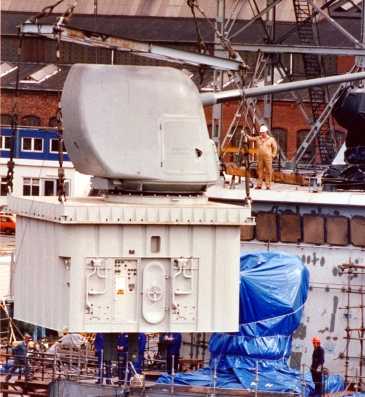



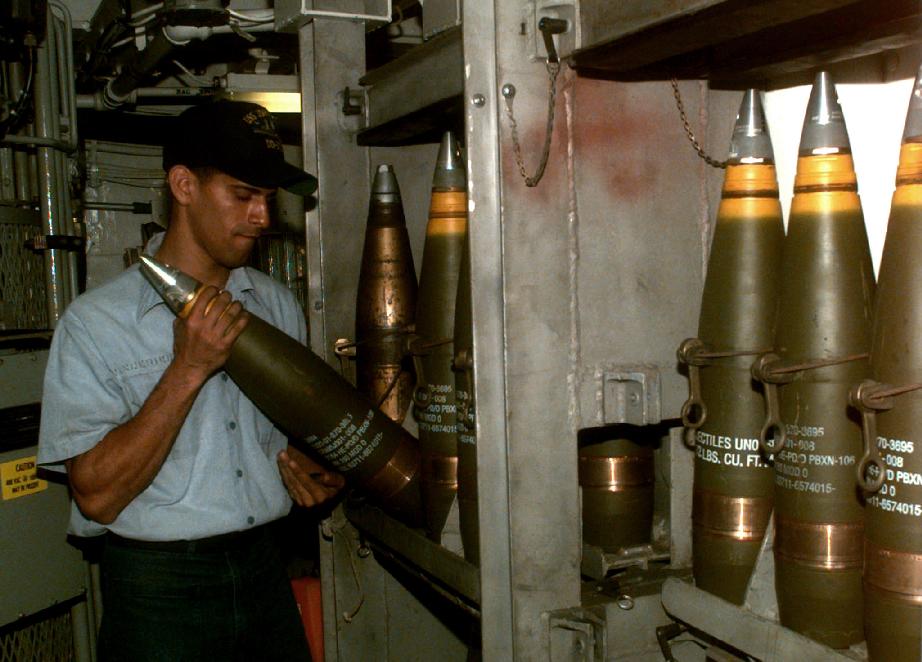

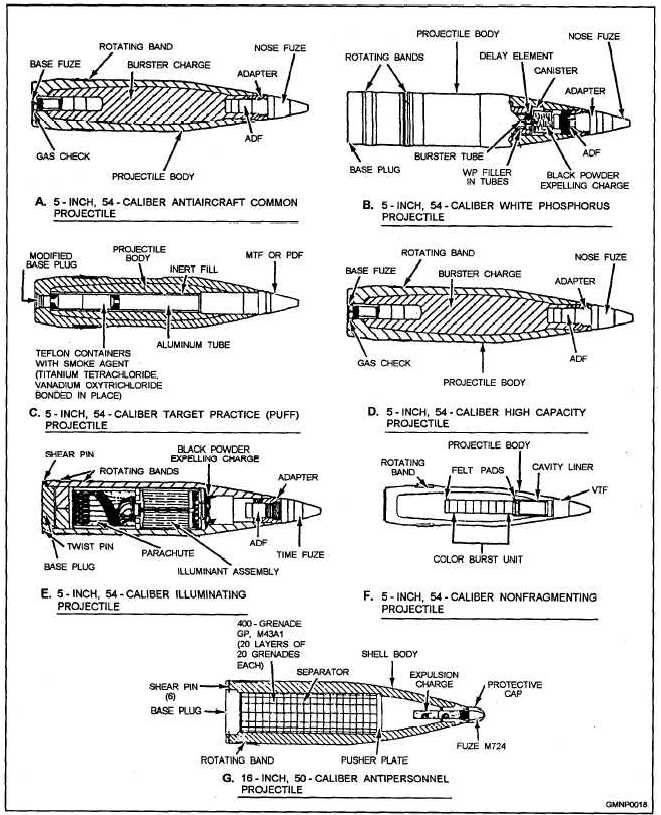
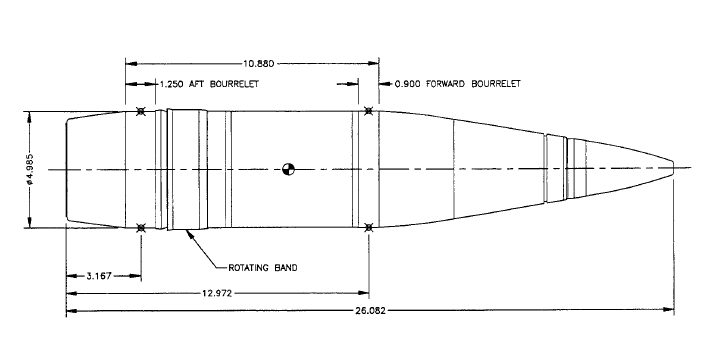

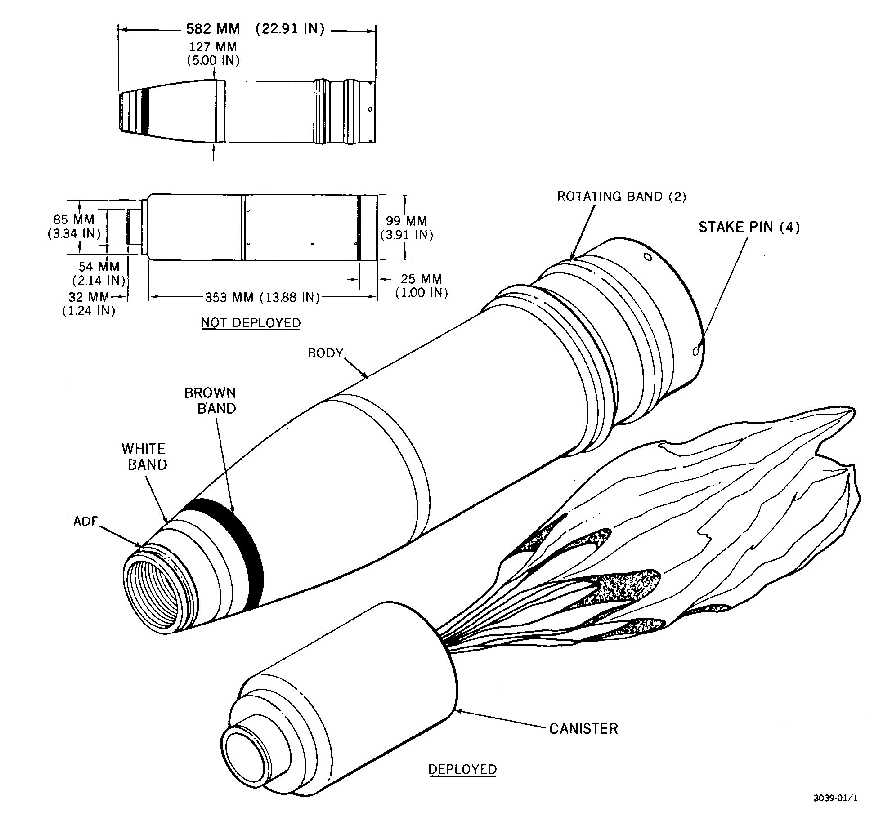
"US Naval Weapons" and "The Naval Institute Guide to World Naval Weapon Systems 1991/92" both by Norman Friedman
"The US Navy's Mk 45 Gun" article by Antony Preston in "Warship - Volume VII"
---
NAVSEA 5-inch Gun Ammunition Fact Sheets
---
"Rapid Assessment of Small Changes to Major Gun and Projectile Dynamic Parameters" by Thomas F. Erline and Leo L. Fisher, Army Research Laboratory
---
BAE Press Releases
US Navy Fact File
United Defense Press Releases
"Concept of Operations for Surface Combat Land Attack Warfare, 2005-2015" by Department of the Navy, 2003
---
Special help by Leo Fischer
18 September 2007 - Benchmark
16 June 2010 - Added sketches of Illumination Round
26 September 2011 - Added details on usage
29 July 2016 - Converted to HTML 5 format
08 September 2020 - Reorganized notes
10 February 2022 - Removed broken link

